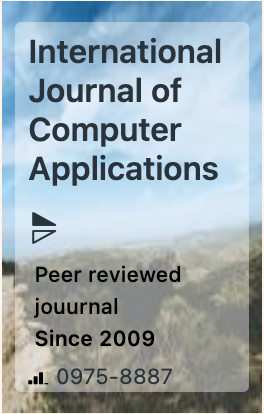The week's pick
Random Articles
Reseach Article
Navigating the Future of Cybersecurity: A Strategic Approach to Crypto Agility for Modern Enterprises
| International Journal of Computer Applications |
| Foundation of Computer Science (FCS), NY, USA |
| Volume 187 - Number 20 |
| Year of Publication: 2025 |
| Authors: Aditya Gupta |
 10.5120/ijca2025925304
10.5120/ijca2025925304
|
Aditya Gupta . Navigating the Future of Cybersecurity: A Strategic Approach to Crypto Agility for Modern Enterprises. International Journal of Computer Applications. 187, 20 ( Jul 2025), 8-33. DOI=10.5120/ijca2025925304
Abstract
Cryptographic agility, the capacity to swiftly update cryptographic algorithms, keys, protocols, and certificates, is a cornerstone of modern cybersecurity resilience amid rapidly evolving threats like quantum computing, certificate authority (CA) breaches, and shortened TLS certificate lifespans. This whitepaper delivers a comprehensive analysis of cryptographic agility, synthesizing historical transitions (e.g., DES to AES, SHA-1 deprecation) with contemporary challenges, including quantum vulnerabilities to RSA and ECC, as well as PKI trust incidents (e.g., DigiNotar 2011). We define cryptographic agility across technical, operational, and governance dimensions, introducing the Crypto-Agility Maturity Model (CAMM) to benchmark organizational maturity from Initial to Sophisticated. A novel Cryptographic Agility Maturity Survey, comprising 10 questions (multiple-choice, Likert-scale, open-ended), is presented, revealing critical gaps - 68% of organizations lack comprehensive cryptographic inventories - while offering actionable recommendations. The study employs a mixed-methods approach, integrating qualitative synthesis of frameworks (CAMM, FS-ISAC, NIST), technical analysis of post-quantum cryptography (PQC) metrics (e.g., Kyber’s 1,568-byte key), and case studies (e.g., Microsoft 2023 outage, Estonia 2017 success). Sector-specific insights for financial services underscore regulatory pressures (e.g., DORA, PCI DSS) and long-term data risks. Best practices emphasize governance, automation, and hybrid cryptography, addressing challenges like legacy systems and skills gaps. Strategic recommendations and a future outlook, aligned with NIST’s 2035 PQC roadmap, provide an actionable path forward. This paper offers cybersecurity leaders a rigorous and practical framework to future-proof cryptographic infrastructures, making a timely contribution to the field.
References
- U.S. Department of Homeland Security, “Crypto Agility,” Cybersecurity and Infrastructure Security Agency, 2023.
- Hochschule Darmstadt, “Crypto-Agility Maturity Model (CAMM),” 2022.
- NIST, “Advanced Encryption Standard (AES),” FIPS PUB 197, 2001.
- NIST, “SHA-1 Deprecation,” NIST Special Publication 800-131A, 2011.
- NIST, “Transitioning the Use of Cryptographic Algorithms and Key Lengths,” NIST SP 800-131A Revision 2, 2019.
- Microsoft Security Blog, “The Future of Cryptography,” 2022.
- FS-ISAC, “Crypto Agility: Preparing for Post-Quantum,” 2024.
- DHS, “Cryptographic Agility for Critical Infrastructure,” 2021.
- NIST, “Cryptographic Agility in Practice,” NISTIR 8347, 2023.
- NIST, “Post-Quantum Cryptography FAQs,” 2024.
- NIST, “Guidelines for Cryptographic Algorithm Agility,” NIST SP 800-130, 2016.
- ISARA Corporation, “Crypto Agility Whitepaper,” 2020.
- Entrust, “The Path to Crypto Agility,” 2022.
- Hochschule Darmstadt, “Defining Crypto Agility,” 2021.
- Microsoft, “.NET Cryptographic Services,” 2023.
- IETF, “TLS Protocol Agility,” RFC 8446, 2018.
- IETF, “Guidelines for Cryptographic Algorithm Agility,” RFC 7696, 2015.
- IoT Security Foundation, “Crypto Agility for IoT,” 2023.
- IEEE, “Context-Aware Cryptographic Agility,” 2022.
- Keyfactor, “The Importance of Cryptographic Inventory,” 2023.
- Shor, P., “Polynomial-Time Algorithms for Prime Factorization and Discrete Logarithms on a Quantum Computer,” SIAM Journal on Computing, 1997.
- NCSC, “Preparing for Quantum-Safe Cryptography,” 2024.
- NCSC, “Quantum-Safe Migration Timeline,” 2024.
- White House, “National Security Memorandum 10: Promoting United States Leadership in Quantum Computing,” 2022.
- NCSC, “The Quantum Threat to Data Confidentiality,” 2023.
- NIST, “Post-Quantum Cryptography Standardization,” 2024.
- NIST, “FALCON Signature Scheme,” 2024.
- NIST, “Hybrid Cryptography Guidelines,” NISTIR 8347, 2023.
- Keyfactor, “Certificate Management Best Practices,” 2023.
- Fox-IT, “DigiNotar Breach Report,” 2011.
- Ars Technica, “DigiNotar Bankruptcy,” 2011.
- Google Security Blog, “Symantec Distrust,” 2017.
- Entrust, “CA Compliance Update,” 2024.
- ISACA, “Crypto Agility and PKI,” 2022.
- Google, “Proposal for 90-Day TLS Certificates,” CA/Browser Forum, 2023.
- Chrome Security Blog, “Shorter Certificate Lifespans,” 2023.
- Keyfactor, “State of Machine Identity Management,” 2023.
- Microsoft, “July 2023 Outage Post-Mortem,” 2023.
- Google, “Google Voice Outage,” 2021.
- Venafi, “Certificates: Feature, Not Bug,” 2023.
- Hochschule Darmstadt, “Crypto-Agility Maturity Model,” 2022.
- FS-ISAC, “CAMM Adaptation for Financial Services,” 2024.
- Hochschule Darmstadt, “CAMM Implementation Guide,” 2023.
- FS-ISAC, “Level 4 Crypto Agility,” 2024.
- Hochschule Darmstadt, “Measuring Crypto Agility,” 2022.
- FS-ISAC, “Financial Sector Crypto Agility,” 2024.
- FS-ISAC, “Practiced Level Characteristics,” 2024.
- FS-ISAC, “Sophisticated Crypto Agility,” 2024.
- FS-ISAC, “Nine Core Elements of Crypto Agility,” 2024.
- FS-ISAC, “Cryptographic Inventory Best Practices,” 2024.
- FS-ISAC, “Training for Crypto Agility,” 2024.
- FS-ISAC, “Applying the 5 Rs to Legacy Systems,” 2024.
- HHS CMS, “Crypto Agility Guidance,” 2024.
- NIST, “Post-Quantum Cryptography Transition Roadmap,” NISTIR 8547, 2023.
- NIST, “PQC Transition Timelines,” 2024.
- NIST, “Sector-Specific PQC Strategies,” 2024.
- FS-ISAC, “Challenges to Crypto Agility,” 2024.
- OWASP, “Cryptographic Implementation Risks,” 2023.
- ISARA, “Software Lifecycle and Crypto Agility,” 2020.
- FS-ISAC, “Legacy Systems and Crypto Agility,” 2024.
- FS-ISAC, “Importance of Cryptographic Inventory,” 2024.
- FS-ISAC, “Skills Gaps in Cryptography,” 2024.
- FS-ISAC, “Third-Party Dependencies,” 2024.
- FS-ISAC, “Automation for Crypto Agility,” 2024.
- Keyfactor, “Certificate Outage Costs,” 2023.
- ISACA, “Cryptographic Governance Best Practices,” 2022.
- Keyfactor, “Building a Cryptographic Inventory,” 2023.
- Venafi, “Automation for Certificate Management,” 2023.
- Sullivan, B., “Crypto Agility in Software Design,” Black Hat, 2010.
- Cloudflare, “Hybrid Post-Quantum TLS Experiments,” 2023.
- FS-ISAC, “Vendor Collaboration for Crypto Agility,” 2024.
- FS-ISAC, “Modernizing Legacy Systems,” 2024.
- FS-ISAC, “Training and Drills for Crypto Agility,” 2024.
- FS-ISAC, “Monitoring Crypto Agility,” 2024.
- PCI Security Standards Council, “PCI DSS v4.0,” 2022.
- EU, “Digital Operational Resilience Act (DORA),” 2022.
- Estonian Information System Authority, “ID Card Vulnerability,” 2017.
- e-Estonia, “Response to ID Card Vulnerability,” 2018.
Index Terms
Keywords

